#this is the definition is perfect <3< /div>
Explore tagged Tumblr posts
Text
one of the things that makes (movie) poolverine work so well is that i think wade is legit the only love interest in these movies that has not ever told logan who he is. like the whole "you're not an animal, logan", and "girls flirt with the dangerous guy but they don't take him home" deal. wade has never really done anything like that, in fact he's pretty encouraging of whatever the fuck logan feels like doing at any given moment.
#wade is both “my boy is gonna fuck you up” and “you're the literal definition of the perfect hero and moral standard”#santi talks#deadpool and wolverine#deadpool#deadpool 3#wolverine#poolverine#deadclaws#logan howlett#logan#wade wilson#hugh jackman#ryan reynolds
762 notes
·
View notes
Text








Junior Panachai as Faifa and Santa Pongsapak as Gun in Perfect 10 Liners ep 13
#perfect 10 liners#perfect 10 liners the series#junior panachai#santa pongsapak#asianlgbtqdramas#asianlgbtdrama#esmetracks#uservix#*#*p10l#these are not my prettiest gifs but i'm struggling with coloring today for some reason#i'll blame it on the fact that i'm definitely getting sick. so on that note i'm going to bed night night <3
191 notes
·
View notes
Text
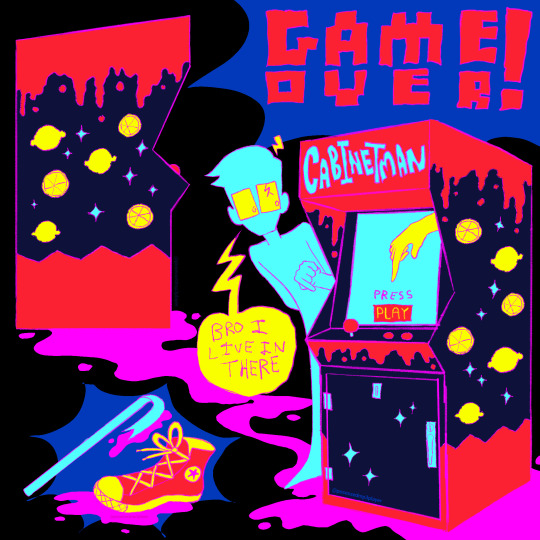
Guys he lives in there (click for better quality PLEEASS)
#lemon demon#spirit phone#cabinet man#my art#⭐️#I think i did a good job with the hands in this but they definitely look a little off#the composition is kinda weird too but changing it would change the entire drawing and i like this drawing#I see people drawing cabinet man as either just a box with a screen on it or the most detailed shaped thing ever so I went in the middle#it's definitely not perfect because I didn't know perspective stuff AT ALL when I made this.#also on the left one it's way too wide it wouldn't need to be that thick it could fit everything if it were like 3/4 the width#I mean my only real world reference point was a modern one without the crt screen so maybe not but I think it'd be fine#if i draw something like this again (which i won't soon because this is still getting notes) I'd put some dimension in the screen#maybe find a reference image
468 notes
·
View notes
Text
....now considering whether I want to write a 'Find the shapeshifters' fic for SVSSS too
#the key thing would be deciding who all is in the party when the doubles happen#luo binghe#liu qingge#shen qingqiu#and yue qingyuan#seem like the most obvious candidates#so far the only 'telling traits' I can think of would be#1) Shen Qingqiu's 'Luo Binghe' is impossibly suave and hits on any female figures within a radius#which leads everybody else to say 'Yeah that's fake' because they all know LBH only has eyes for SQQ#and 2) I think Yue Qingyuan's 'Shen Qingqiu' is kind of ragged and underfed#even now#he can't stop seeing him that way. a little bit.#oh 3) luo binghe's 'Liu Qingge' would just be OFFENSIVE. probably his 'YQY' too.#4) if Shang Qinghua is in the group that's going to make things difficult#because shang qinghua's doubles are almost all perfect#except for Shang Qinghua's 'Shen Qingqiu'#who he definitely gets wrong in some way#because Shen Qingqiu is the only one here that Shang Qinghua did not create
493 notes
·
View notes
Text

I absolutely HAD to draw something for @phoebepheebsphibs's DTIYS (based on this pose)! I decided to mix things up a bit by experimenting with a more limited color palette, which was a pretty fun challenge.
#rottmnt#rise of the tmnt#pheebsdtiys#art#my art#my post#tmnt#alt text#dtiys#mikey#uify#until I found you#I don't actually know how clothing folds work#my “method” is throwing a bunch of stuff against the wall and seeing what sticks#which is basically my method for drawing in general I guess#trial and error#but I've definitely improved since I started so I guess it works right?#anyways#it's like 5am as I'm drafting this post#just finished feeding my daughter and waiting for her to fall asleep before I go back to bed#perfect time to draft a post and ramble in the tags right?#my schedule has gotten so weird with a newborn#but I make time for drawing turtles where I can#saw this dtiys and knew immediately that I had to do it#stayed up way too late doing it probably#but those 2-3 hour intervals where she's sleeping are a good chunk of my free time nowadays#and I am more than happy to spend them drawing uify mikey
198 notes
·
View notes
Note
could you pretty please perhaps draw Richie x Jason 🙏🙏💗
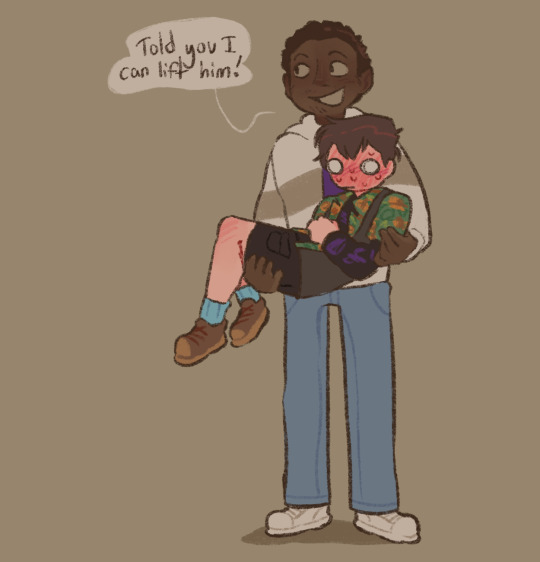
kyle put him up to this
#jason jepson#richie lipschitz#jepschitz#hatchetfield#definitely art#id in alt text#big fan of jason and his 2 braincells#they would have the slowest burn because richie would wait for him to offer to carry his books and jason would take richie basically#on a date and be like “yay my dude im so happy we could hang out like friends yknow buddy :]” while internally congratulating himself for#being a good boyfriend. in my perfect world they went to homecoming together#and richie looked at him with moe eyes while twitching his fingers like “uh.. w.. what... does this make us...?”#jason looked at him with a blank expression and went “have we not been dating for 3 months”
379 notes
·
View notes
Text
After the fifth time that Katsuki pops up at UA, surprising Izuku with Bento for lunch, calling him "sensei" in a cocky(affectionate) tone, Kouta just stops at Izuku's desk on his way out of the room and asks him point blank,
"So are you and DynaMight actually dating, or what?"
Izuku sputtering and dropping all of his paperwork and avoiding the question out of sheer dumbfoundedness.
Then, the sixth time that Katsuki barges in, as he is thrusting the bento into Izukus hands as usual, Kota raises his hand, and stands up from his seat and yells out,
"DynaMight, sir!! Pardon me, but are you dating Deku-Sensei??" And the whole class gasps and whispers. Katsuki appears just as dumbfounded as he looks wide-eyed at Kouta and the students.
"Kouta!" Izuku balks, but then Katsuki suddenly grins mischievously. Izuku doesn't trust that look...
"Well, brat, maybe I SHOULD date him, then I could make sure Sensei doesn't forget to eat every day, right??" Katsuki looked entirely too pleased at the louder gasps and chatter that came from the students. He has a wicked grin as he turns his sharp red eyes back to Izuku.
"K-Kacchan, what are you doing?!" Izuku stammers, beet red and grabbing his arm. "This is not the time for--"
"If you don't want me disrupting your class, then stop leaving your Bento in the fridge!!" Katsuki scolds Izuku before swinging himself back out of the open window. There was a fresh wave of gasps and excited murmuring at the insinuationthat the two lived together. "We're ROOM MATES, OK?" He adds hastily, pointing his finger at the noisy classroom of kids.
He drops out the window and blasts off.
Izuku is left, stood at his desk, hands planted and hanging his head, trying to collect enough of himself to quell the riotous theories now flying around his classroom.
Kouta stands at his own desk amidst his unruly classmates, eyes narrowed as if he had just realized something, "I knew it!" He hisses.
"You're the worst," Izuku texts Katsuki later.
"I know" katsuki replies.
"Now eat your fuckin food or I'll stop making it for you."
--
I think I was inspired by this art post ^^;
#bakudeku#post epilogue bkdk#post epilogue drabble#deku sensei#dynamight and deku sensei#in this one they are definitely room mates :3#oh they were roommates#kouta knows the trope apparently#he is familiar with it#kacchan prepares meals each day#izuku forgets to grab his sometimes#so Katsuki flies it over to UA before going on patrol#gives sensei some grief#some days more than others#izuku now understands why aizawa is so tired all the time#kids are rowdy especially when they get wind of some tea#its ok kids katsuki is waiting until the perfect opportunity to ask izuku out#when theyre both heroes again#when theybshoot to the top of the ranking#just give it time#the class starts shipping them#izuku doesnt always remember to grab his bento even after that bc dude is tired#but kacchan always brings it and riles everyone up#its almost as if he likes doing it#likes flustering Izuku#aizawa is not pleased#he worried about the learning environment#hes this close to forbidding izuku to accept kacchan brining his lunch on campus at all#his problem children continue to be his problem#and for this drabble i am assuming that the windows in the UA classroom can open
174 notes
·
View notes
Note
Hello! I'm someone with autism (and I'm suspecting ADHD too) who's planning multiple projects. Do you have any advice when it comes to overthinking a lot about decisions on a project? Be it the first step, planning, questioning if you're moving too fast, etc?
ouuuu I think the biggest thing I struggle with personally is just like... the overbearing weight of expectation that isn't necessarily even there. Like, expectation to do everything right all the time, to never make mistakes, to never fall through on promises, to never break any 'rules' (real or imaginary) and most of all, for everything I do to matter in some big, recognizable, memorable way - but the steps to that goal aren't defined, I just know what the goal looks like, with no clear path as to how to get there, and so it often results in me aiming at my own "best guess" and then beating myself up for not hitting the target LOL which is completely unfair to myself and my own work!
What I try to regularly remind myself of is that I am one person, who is only capable of what one person should reasonably be able to accomplish on their own, no matter how much my auDHD tries to convince me otherwise that I "should" be able to handle more than what's reasonable. And in that same sense, there isn't any more pressure on me to put out something perfect than there would be on any other person. I am not Atlas carrying the fate of the greatest work known to mankind on my shoulders - I'm a chronically online dweeb making stuff that's interesting to themselves and sharing it in the hopes that even just one other person will like it too. That isn't a diss on myself, that's me embracing what I am so that I can keep doing it better and more confidently each time.
Though I don't know if this exactly applies to you, I'm gonna say it just in case: I know when it comes to balancing multiple projects, it can be hard not to go "oh well I SHOULD be working on xyz!" but at the end of the day, you're not a failure for preferring to work on something else or needing space from projects that used to thrill you and have now become monotonous. In fact, it turns out that's how it is for most neurotypical people too! I know they make a lot of shit look easy, but even they have shit they loathe doing - they just don't have to deal with the unique hurdles of being neurodivergent.
Always remember to set boundaries with yourself and your work. Remember, just because you're really excited to work on something, doesn't mean you have to work on it all the time. I've learned to appreciate those moments when I'm stuck doing my day job and I'm excited to get home and work on my passion project, because it means I can actually look forward to it and it'll feel all the more rewarding when I finally get to do it! Pushing yourself too hard to fulfill that excitement all at once right off the bat often just means you're gonna spend it all way too quick, and that won't feel good because then you'll be left wondering where all the love went.
Set little goals for yourself. Stuff that's manageable and achievable within a reasonable amount of time. I know we tend to dive into thinking huge right off the bat, because that's what's exciting to us, but when it comes time to actually do the work, those smaller goals can keep us moving forward far better than the big, far off, ambiguous goal hiding somewhere off in the horizon. While it's good to plan ahead, not setting smaller milestones for yourself can burn you out faster because it's really hard to work towards an "end goal" that might be too far away for us to even conceptualize. The small goals allow us to reward ourselves along the way, and they do ultimately still build up to the bigger picture in the end, even if it feels like we're "not doing much". It can be anything like "get to this chapter that I can finish in the next few weeks" or "fully write out this scene that's been living in my head rent-free".
As for the overthinking... yeah, I wish I had some magic solution to that, but it's really just about learning what you enjoy doing vs. what you don't, so that you can have confidence in knowing when your creative decisions suit the project you're working on. This is something that gets better with practice and experience, but I feel like it's better tackled by reminding yourself that any project, no matter the outcome of how popular it gets or whether or not it "takes off", is an opportunity to learn and grow. Treat every project as a learning experience and you'll hopefully find the process itself more enjoyable, which will subsequently buff up your confidence. It's all a process of honing in on what works for you, what you excel at, and what you enjoy doing; while learning what doesn't work for you, what you could improve at, and what you don't enjoy doing.
Finding a writing buddy or someone who's willing to read your work and give you feedback is super helpful for this, too, because sometimes it takes another perspective to help us navigate the fog of indecision and find a solution.
And again, remember - you are one person, and you are under no obligation for any of your projects to be some perfect, infallible holy grail. You will write stuff that you will inevitably look back on with disgust and cringe. You will create projects that you will eventually outgrow or move on from. That does not invalidate the time and effort you put into those projects - it's proof of experience and growth. Embrace the growing pains, find peace in the process in whatever way you can.
It's not a question of right or wrong - it's asking yourself what feels true to you and your voice, and finding out along the way.
#writing advice#ask me anything#anon ask me anything#anon ama#ama#and that is my bag of cents!#idk how helpful this is but i hope a little bit of it resonates with you!#it's definitely hard esp when it comes to the imposter syndrome and self-doubt#but the biggest thing is just being patient and kind with yourself#you're allowed to write stuff that isn't perfect! most stuff isn't perfect! even the stuff that we really enjoy!#and you're allowed to take your time and create things at your own pace#there's no divine punishment waiting to strike you down if you don't accomplish everything right this second#just take it one day at a time and find your joy in the process of creating your art <3
70 notes
·
View notes
Text
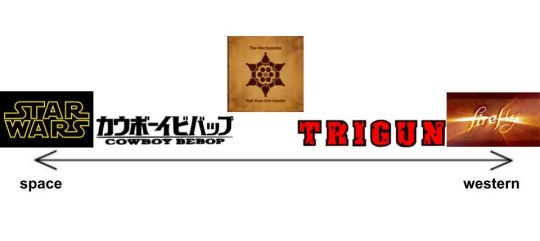
I've come to some conclusions about where space westerns fall when it comes to "more space" and "more western"
#star wars#cowboy bebop#high noon over camelot#trigun#firefly#I love space westerns <3 my favorite genre <3#hnoc is the perfect space western in my taste bc it is the perfect medium#between space and western#I could see cowboy bebop and trigun getting scooched around#but star wars and firefly are definitely the end poles#this is just my silly little takes
746 notes
·
View notes
Note
Wait so how do you know for sure the sprite is Ralsei? No hate, I do believe you haha, but I too am a lore scientist and I wanna know your evidence. Does it show up in-game? I could definitely believe that I saw it in-game and forgot about it :P
YES. Finding legitimate sprites directly from Toby Fox games can be surprisingly difficult. There are so many fan-made character sprites, that it can be hard to differentiate from the real ones!
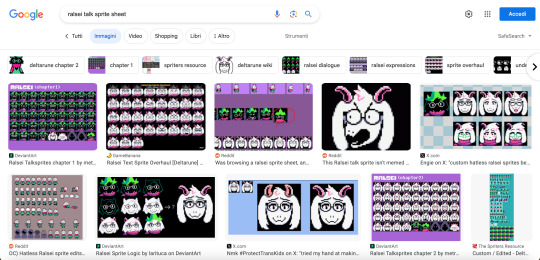
Guess how many are NOT fan-made? .....only one 🗿
...(please don't question why google is in italian)
Official Websites like Spriters Resource (Ralsei's Offical Sprite Sheet) are very helpful in this regard :)

They may even include unused file graphics. Like this unused face of Ralsei.

Sprite legitimacy is a big rabbit hole that I personally don't have enough knowlege on :( ((BUT OH MY GOSH The internet is notorious for reposting fan-spriteworks without sourcing. It can be really hard to find the original artist.))
It's also HILARIOUS how many people have redone Ralsei's sprite. It is quite obvious from my Ralsei poll and through his mass of fan-redesigns, that many people in the Deltarune community REALLY LOVE his Chapter 1 sprite more.
Ralsei sprite fan-art is amazing and I personally want to mod it into my game bc it looks so good. Below I have some really cool fan-sprites I found and the artists who made them!
Left (Ralsei Ch 2 redesign- metr0nix727), Middle (Ralsei based off Ch 1- larituca), Left (Full Ralsei Chapter 2 Sprite sheet with Hat- artist unknown**)
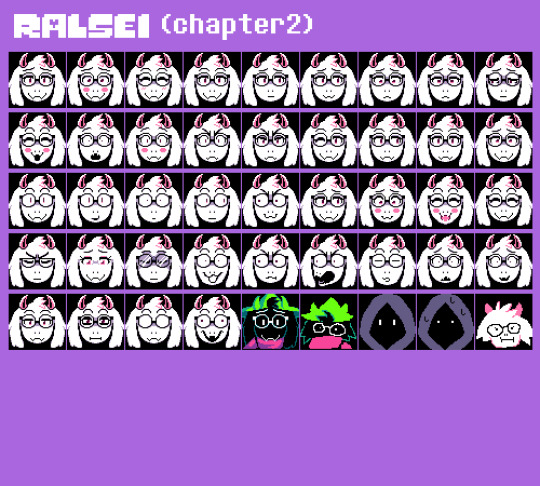
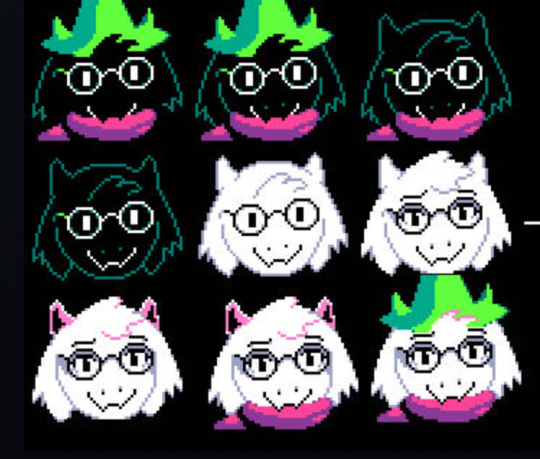
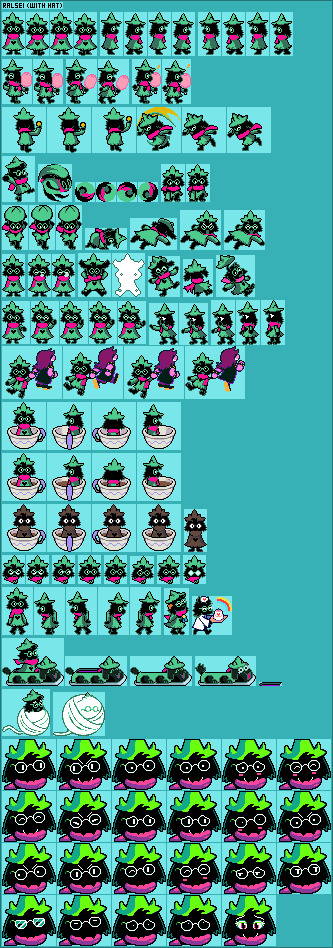
**this sprite sheet was submitted through Sprites Resource but I traced it back to TaxeisNotOkay, who I presume to be the original artist. I could not find any other information regarding the full sprite sheet, so feel free to correct or inform me if you find anything!
Looking back at Ralsei's Chapter 2 head sprites..... they just don't look as good as they could in my opinion. I dont like them :(...uhhh NO HATE OF COURSE!!..ahklasdkflansdf I'll go jump in this hole now.
#I want to reiterate I do not hate people who like Ralsei's Chapter 2 design. But I myself have MANY criticisms for it-#I have a lot of other criticisms for Deltarune in general!! And thats okay!!! No game is perfect. <3#But Being able to voice my criticism definitely makes me feel less alone.... I want to feel comfortable expressing my thoughts and feelings#.....Idk I think its important.... QwQ...ahh sorry...anyways....#You got me rambling again uwu#This was a super interesting deep dive into sprite work! SO thank you to whoever asked!! <3#deltarune#deltarune fanart#sometimes its almost like the community itself makes better content and i get....conflicted... idk man..... :(#deltarune sprite#fanart#ralsei#ralsei deltarune#deltarune ralsei#ralsei sprite#bread#bread rambles
305 notes
·
View notes
Photo
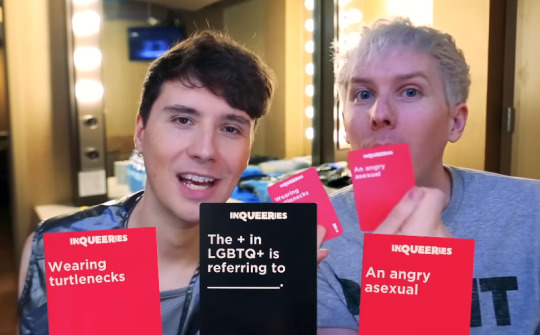
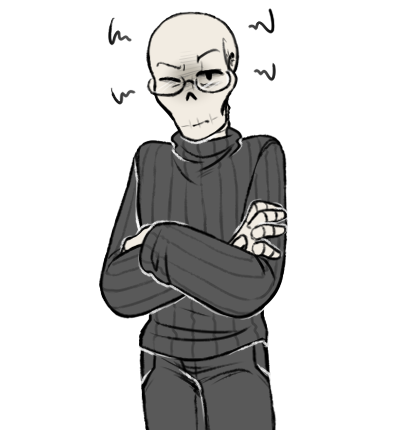
I was inspired from on high (Patreon)
#DDoodles#Shitpost#Dan and Phil#UT#Handplates#Gaster#What a tag combo lol#POV: You insulted the Dreemurrs#The G in LGBT stands for Gaster now you know#AroAce skelefam supremacy lol - the whole skeleton family tree are aroace we love them for that <3#Someday I'll write that essay proper about why all my faves are aro/ace to some capacity lol#For now it's goofs and gaffs#Literally As Soon as they both played these cards - I am so thankful to Phil for making an ace joke to the + honestly#Nothing drives me up the wall more than ''A is for Ally'' like no tf it is not thank you <3 If you must you can have a second A but come on#So the + ace joke primo excellent thank you#Dan was immensely correct for his addition tho - made it too perfect I immediately saw Gaster's grumpy face about it#I see him everywhere............... (lol)#Extremely excellent and correct choices leading to an inspiration this is why I watch them religiously#Definitely no other reasons like they're a bright spot in this dark world always deriving joy and light#Gaster also fits that bill huh - too many beautiful lads out there really thank you <3#Alright enough silliness for now#Love yous#<Oh you can barely tell that I was tipsy while writing these tags lol
69 notes
·
View notes
Text
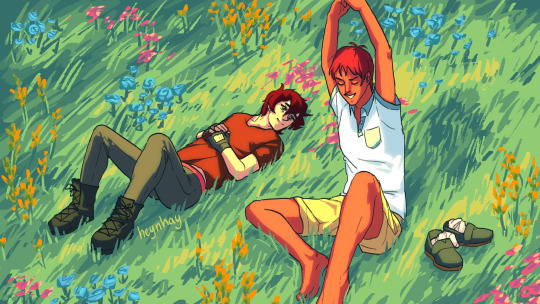
i love everybody because i love you
#klance#vld#voltron#lance mcclain#keith kogane#heynhay sees keith and is like DOCTOR!!!! TAKE THAT MANS PATHETIC CAT AURA OUTPUT AND INCREASE IT BY TEN THOUSAND!!!#i need you guys to listen to the linked songs. tell me you do that#because i cannot make it clear enough that i dont just choose a similar ish song. when i link a song in the desc it means from start to end#i had that song in mind. or even playing. definitely looped it several dozen times#and this is an easy one too! one like everyone knows! i didnt even go niche this time!#(strawberry blonde was just too perfect)#it was a hard choice between this and I Want You though for RFSNCIB#anyway thats 3/6 mitski albums represented.#can i keep doing one a day til i finish? dubious. but possible.#just for the record. after this keith like lit a building on fire or something#he couldnt fucking take it anymore#caption is a bit misleading. keith would not love everybody bc he loves lance.#in fact i think mostly it would drive him to threaten others with violence#but for a split second. this split second.#...maybe he does#art#my art#mitski
733 notes
·
View notes
Text
So, how rare ARE Ford's extra fingers, anyway?
I'm not gonna lie, at first I was skeptical of Ford's claims that the Weirdness Magnetism had an effect on him. Like, yeah, the whole having six fingers thing isn't exactly common, but it's a naturally-occurring event. Stan describes it as a birth defect, and there doesn't seem to be a noticeably great number of people with those in Gravity Falls. It wouldn't be all that farfetched for Ford to think he was just Built Different, for like, at least 7 reasons, but then you start actually thinking about it.
Polydactyly isn't exactly common. Approximately 1 in 1,000 babies are born with some form of polydactyly. While it's true that postaxial polydactyly (extra digit is past the pinkie) is the most common form, which is shown to be the kind Ford has in the x-ray at the beginning of AToTS, there are several other extreme circumstances.
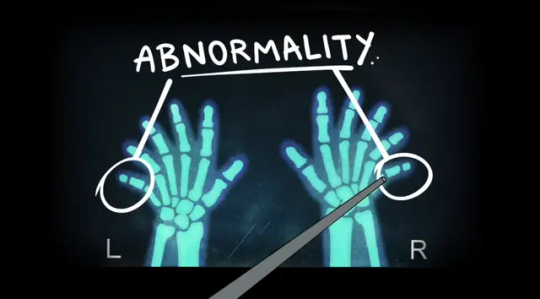
Extra digits in polydactyly aren't usually found on all limbs. It can occur on hands and feet (and Alex has confirmed that Ford does, indeed, have six toes on both feet) but rarely does it occur on both feet, or both hands, much less both hands and both feet. And even when it does occur more than once on one person, the extra digits aren't usually fully-formed. Oftentimes they don't even have bones. When they do have bones, they're usually much smaller, or barely opposable (if they have joints at all). When they're big enough to be maneuverable, they usually interfere with the structure of the hands/feet in negative ways. All this means that an extra finger or toe which doesn't direly require a surgery to remove the extra digit within the first year or two of life is incredibly uncommon.
And let's remember: that's just for one extra digit. Ford has four.
For Ford to have fully functional polydactyly on both hands and both feet, to the point where it's basically impossible to tell which one is finger x without x-rays... the odds of that are astronomically unlikely. Never-before-recorded, one in a kazillion, borderline medically unfathomable sort of rare.
I think I do believe the Weirdness Magnetism could've affected Ford, actually.
#I don't think the same about Dipper and his constellation birthmark tho#I have freckles on my arm that make a perfect right triangle u ain't special#while such a large birthmark is certainly rare it isn't unheard of#the actual structure isn't technically any more or less likely than any other random arrangement of dots and lines#unless the fact that it's a constellation makes it special in some way which would make sense but we never saw any supernatural connection#i definitely think that part is just Ford being like “look at my grandnephew :) he is a Special Little Guy I love him he's great”#which is extremely adorable but not indicative of any weirdness in a scientific sense of the word#i can't believe i just typed “weirdness in a scientific sense”#gravity falls#journal 3#gravity falls journal#gravity falls spoilers#ford pines#stanford pines#dipper pines#gravity falls meta#i think#is this what meta is?#am i metaposting?
234 notes
·
View notes
Text
Trying to absorb everything there is to know about ice hockey within the shortest amount of time possible really does strange things to a person. You come up against questions such as what do defensemen even do aside from skate backwards and do tummy time to protect their goalie? (Broadcasts aren’t the most informative) What the hell makes defensemen effective? What do the casters mean when they say “gap”? What are defensive details?
I love watching games back, I love trying to understand the game. I love hockey <3 But sometimes it’s nice to have help, and sometimes my favourite writers/podcasters collaborate!!
Here is part 1/3 of a podcast mini-series about defending, putting it here so I can have a copy of it in case it ever gets taken down + wanted to share with everyone some of my findings! (All episodes are available if anyone just wants to listen to them!) Transcript + edits done by me, all mistakes are mine.
Published 6th November 2024, Hockey IQ Podcast: Modern Defensemen (with Will Scouch) Ep #1 - by Hockey's Arsenal, hosted by Greg Revak (apple / spotify / youtube / bonus substack link)
part 2
[START Transcript]
Greg Revak: On the Hockey IQ Podcast today, we open up a new segment: we’re bringing back our favourite Will Scouch. If you’re on the Hockey IQ Newsletter you know his work by now.
Will, good morning. Earlier than most of us probably normally get up, but it’s a good day.
Will Scouch: Yeah, Greg, thanks for having me, it’s a lot of fun. Me and Greg go way back. We’re boys from years ago and I’m excited to hop on the show. I’m a keen listener, keen reader.
[They exchange pleasantries]
GR: Beautiful. Well, today we’re gonna talk about three concepts. We’re gonna break it into three spots though, so everyone’s gotta come back next week and the week after that.
We’re gonna talk about defensemen, because everyone knows they’re important but how do we actually play the position well?
WS: Yeah, I mean, it’s a position that’s still, to me, being explored; both by, I’d say youth and junior coaches and pro coaches alike. There’s a lot of different ways that you can do it.
I mean, I watch a lot of hockey from around the world, all kinds of different levels. I’ve watched guys develop from 15 to 24 at this point, and just seeing how their games evolve and everything, and how effective various versions of this position is. And I think it’s a very interesting area that’s still being explored in a lot of really interesting ways, for sure.
GR: Yeah, I think back to David Savard; he comes out of the [QMJHL] as this high-flying offensive defenseman, and if we just forgot about the rest of his career and you just saw him today as this great shutdown, defense-first player, you’d be absolutely shocked.
I mean, you think about Rasmus Dahlin — kid didn’t even play full time defenseman until his actual draft year, he was still playing forward a ton. There’s so much to be explored here.
I feel like [to get a lot of] — for you NHL fans — to get a lot of value in the later rounds out of your defensemen, take those offensive players first, and we can find a lot of hidden gems later.
WS: Well, yeah. I mean, actually, I’ve said this a few times but your listeners probably don’t know, but I did a presentation during the pandemic at the Ottawa Hockey Analytics Conference about this topic exactly; how, when you look at the numbers and the defensive value of players in the NHL, I found that there were just as many in the top 50 defensive value of players in the NHL, there were just as many undrafted players as there were second round picks, second and third round picks combined.
So the draft isn’t really a great historical gauge on defensive ability. Offense is a different story from defensive players, which we could probably get into a little bit.
But I find, personally, that evaluating defensemen and projecting defense to the NHL is still really spotty and questionable. And I don’t know, in my line of work, watching a lot of defensemen, a lot of the ones who I think are some of the better defenders kind of go a little unheralded, because a lot of the time you don’t need to be particularly noticeable to be a good defenseman, but scouts are always looking for the noticeable guys.
So it’s a very interesting world and it’s a very interesting thing to pick through, but there’s definitely a lot of case studies you could dig into, and a lot of players you could look at as cases of, “Oh yeah, nobody was really paying a whole lot of attention to them!” or maybe people were thinking about them the wrong way. But if you think about things a little bit outside the box, you might be able to see something really interesting there.
GR: Yeah, so let's dive into why that may be. Classic example would be Lane Hutson, so maybe we'll pick on him a little bit, but I definitely want to talk about Rasmus Ristolainen, because he is an interesting case study that we wrote about on the newsletter.
So where I want to start with this is just modern day defending. How are defensemen defending today versus old times? A lot of times it was the big hit, separate the head from body. The puck’s somewhere, but let's separate the head from the body, and we’ll worry about the puck later — that is going bye-bye.
Every coach I talk to now, they prefer having the puck rather than having a head on a stake. So for me, it comes back to this old saying of, “position before possession.” We're gaining body positioning, we're not so much separating head from body, but puck from player.
All right, so we've got position before possession. It's super valuable in gaining the space that you need to have first whack in a puck or put the puck where you want it, or just push it to a teammate. Just having the idea of owning space and there's no better league at this and no league that values it more than the NHL. If you don't do this well in the NHL, sooner or later, you're going to find yourself out of a job making a heck of a lot less money in a league that probably no one really cares that much about. You want to be in the show, the big lights: you have to value this more than anything.
And this is actually the one thing that I noticed about Hunter McDonald. He's in the Flyers’ system now — he was an overager, but I was like, “This guy is unbelievable!” He’s a huge frame, you can’t miss him out there. He would just get the positioning before possession, and I was like, “Okay, that’s interesting, let me watch him further.”
And I feel like he’s going to be one of those bottom of the lineup guys who, unlikely, made it out of being an overager in the [United States Hockey League], going to college for a few years, but has those little details of a defenseman that you see in modern day play, which is positioning overall, which is an NHL trait to the nth degree.
WS: No, I know. I think I would definitely agree. Those are the players that are always really, really fascinating to me because you look at a guy like Hunter McDonald and the production just isn't amazing. But it doesn't — to me, when you look at defensemen, it almost doesn't really matter. That's kind of a very secondary-slash-bonus style of thing that comes with a player.
I see a lot of defenders every year and it seems like a thing where a lot of them, maybe at the lower levels, there is a little bit more of that “separate the head from the body”-type of player. And I think there are NHL scouts who still gravitate towards those guys but, at the end of the day when it all comes out in the wash, it's a lot of the time the guys that are kind of, I hate to say ”boring”, but just very effective, and just they're always in a good position.
The guy I always reference as a young defenseman who, I think, is just a really, really high-end defensive guy is Kaiden Guhle in Montreal. We're going to talk a little bit about Lane Hutson in a second, but Kaiden Guhle is a guy who, when he was in the junior level, just played such a great, balanced style of defense.
He was a good skater, but he had really good length. He was a guy who didn't just lay the body every single time, but he certainly could if he needed to. It was about his lateral mobility, it was about tracking rushes, keeping inside the dot lines, and preventing chances from inside and leading with his stick, but then finishing with the body if he had the opportunity or the need to do so. And he seemed to have a really good read of just how to do his job really, really well.
And so that's been a lesson for me for sure. He was a really interesting case study a few years ago, and he's become a pretty solid NHL defenseman. I mean, on a team this year that’s kind of struggling defensively I think he’s been one of the brighter spots on that defense group there, [he’s] doing a pretty good job at least suppressing chances against.
GR: I don’t watch as much as you do, prospects, but Guhle I did catch. For me, the play style wasn’t very good. He had elements of it, you could see the flashes, but he was just really brash. His decision making and his reads were quite poor. But the tools were there, and it was like, “Can he adjust?” Which I think he’s done a phenomenal job [of], and I think Montreal is probably the perfect place for him to develop a lot of that.
So I think you're spot on like, “Okay, how does he actually apply?“ Having assets is one thing, having the tools is one thing, but how do we properly apply those assets, those tools that you have in a good way? So I think another piece, for me, is if you do have the speed, is just making sure that you're controlling speed and then you're also keeping small gaps.
And just knowing with my high school team that no one knows what a gap is, let's define that real quick, which is: the difference in space between the forwards and the defensemen. So the space in between, “How much space are you [allowing]?” in hockey term slang. It's underneath you versus on the other side, which is above you or behind you. So, “How much space, what's that gap between D and O?”
(Editor’s note: He says O instead of F here, I assume because the person attacking isn’t always a forward. As in, “How much space between the defenseman and offenceman?”)
So you got the speed, shrink that gap as much as possible. Don't give them the space to operate or work in, or, I even call it the space to think, which [it often becomes] for forwards, especially unsophisticated ones.
WS: Yeah, I mean, that's really the bread and butter of a lot of the position. It's so much of this, like you said, gap control. I actually just did a bit of video work for a really high end player, [an] NHL draft pick playing in Sweden this year, who is producing really well.
But in terms of the defending side of the game, he's not the most incredible skater you've ever seen, he's not the biggest guy in the world. And a big thing that I noticed, that even at the professional level that was kind of a bit of a work in progress, was that gap management. Especially because the footwork wasn't amazing, [he was] keeping his feet a little too stationary, gliding backwards and sort of allowing that gap.
And when you watch the NHL that's the point of the whole exercise, watching the NHL and how they play. Forwards are fast and they're smart, largely. The guys who can score are the guys who know how to get through soft defensive pressure, the guys who know how to find lanes and cross up defensemen, and if you don't have the footwork or the mobility or the reach or all of it — all of the above — to track all that and manage it, then it's going to be a lot tougher to do your job.
But the interesting thing, though, is that there's a lot of different ways that you can get defensive jobs done. That's always been very interesting to me; seeing how different players approach the position in different ways and seeing the efficacy of that come out in the wash, and how their offense balances with their defensive ability. It's a very interesting world to dig into, for sure.
GR: Yeah, I think you've got a rabbit hole there. You just kind of opened up around defensive skating. What do clean feet look like? What does defensive posture look like, that actually allows you to have that kind of mobility?
So we'll leave that for another day. If anyone wants to go check it out on the Hockey IQ Newsletter, they can do so. Just look up defenseman skating development. We've got two good pieces there talking about building and maintaining defensive posture and keeping clean feet, which — actually massive base for anyone.
It allows you to have the proper gap that allows you to kill plays early, and ultimately, it's a lot about just controlling speed. You don't want McDavid building up to full speed. You don't want MacKinnon building up to full speed. You don't want anyone coming up to you at full speed. It's very hard to maintain that kind of speed going backwards [that we] even generate in the first place.
How do you kill it early? How do you get a hand on someone? Or, my favorite example is just proper pivoting. A guy dumps a puck on you, how are you going back? What does that pivot look like?
I'll let you open that up because at the NHL it's almost too good, where you can't see what a bad example looks like, but you can see it's everywhere.
WS: Yeah, I mean, it's a make or break skill in the NHL. It's where a lot of defensemen die. I mean, it's a cliche at this point to talk about pucks in deep, to talk about [getting] pucks deep in the offensive zone, get below the goal line, dump and chase. People make fun of dump-and-chase kind of stuff. But if your team is built to do it, you can do it.
You can take advantage of defensemen in the NHL who just don't have the speed or the agility or the skating ability that some of your forwards might have. It is a lot easier to skate forwards than it is to skate backwards. That's just, you know, anecdotal, but also pretty factual — you're naturally going forwards.
I think an interesting trend that you're seeing a little bit more of [is] what they would call ‘scooting’. You're the coach; I don't know if that's exactly what the terminology would be, but [it’s getting] your defensemen in the neutral zone, kind of pinching a little bit more and having them skate forwards, tracking play towards the boards.
So it's not necessarily that they're doing their backwards crossovers, it's not necessarily that they're entirely skating backwards, but you see guys who are really talented skaters or do have a lot of quickness driving play to the boards in a more aggressive way than having the play in front of them. It's about them sort of tracking that play laterally, which is an interesting thing I think you're seeing more of now.
I think there are definitely coaches and systems that love to play their defensemen more that way, and the weak side defense can sort of fill between the dot lines for them and sort of leave the weaker side of the ice a little bit more open. That's kind of what I mean. There's a lot of different ways to achieve these kinds of goals, and I think you're seeing a lot of different things popping up to adapt to this.
In situations where you have a dump and chase or something like that, or just getting pucks in deep or whatever you say, when you have a defenseman who has trouble with their footwork and turning around… Trust me, I'm a defenseman, when I play hockey, I strap on the skates — I play defense myself and that's where I fall apart, when I do fall apart. Which is often. But definitely, when play turns around and I’ve got to change directions or change my area of flow, it can be tricky. And in the NHL, I can only imagine how tricky it can be there.
GR: Yeah. I mean, a good pivot you're looking at three steps total, like boom-boom-bam and you're there. You watch an amateur game and it could be like five, six, seven, eight chops before [they] finally get going and [it’s] looking like a proper forward stride again. [Or just] getting into a good defensive posture and positioning. It's total scramble mode.
A big one for me, too, is just the direction that you pivot. Do you wait for that offensive player to commit to their lane? It's just a great defensive habit in general, letting the offenceman make the first move. If you're making the first move, you're the one showing your cards. It's kind of like showing your cards first in Poker.
Let them make the decision and then you can pivot into them. Now you can get that position before possession, or at least get a chip on them, slow them down. You can either make it easier for yourself or your partner. So one, there's the clean footwork on the pivot, and two is making sure that we're controlling the speed and we're pivoting properly in the direction that we want to pivot.
There's a ton of times where I see, especially the lower levels, players coming up, they're in a bad spot, they're skating forward, defenseman skating backwards and they just chip it off the boards. And the defenseman is like a dog just following the puck and it ends up in the middle of the ice where the forward actually went. Again, the NHL is the best at this so it's really hard to see bad examples of pivoting into and controlling the space of the opponent.
WS: Yeah. I do a lot of work outside the NHL, and the biggest thing I notice is not necessarily the number of chops it takes, but the amount of time. You can see guys taking two seconds, maybe more, to get themselves turned around, tracking pucks below the goal line.
To me hockey is a game of milliseconds a lot of the time, right? I was working with someone years ago who really shared the idea with me that, in the NHL, generally goals are not scored if you have the puck on your stick for more than either half a second or a second.
I can't remember off the top of my head, but it's so fast in terms of; when you score goals in the NHL, it's when you touch the puck for a very short amount of time in the offensive zone and get a puck on net. And so, if you have guys who take too long — and “too long” might not be very long… If the difference is relatively short at the time you're making those pivots or those changes, but the [opponent has] got a lot more speed than you and you're [taking more] time to then start generating that speed to match the opponent, you're in trouble.
And in my opinion, I think that you want your defensemen to be more assertive. I always fall back on the strategy of; make them make a decision, make them commit. That might imply that you do the committing first, but that's where the importance of footwork and tactics come into question.
You have to have strong support, whether it's from backchecking forwards or your partner. You want to be able to adapt to quick players who might fake one way, go another, and be able to use your stick or use your feet or both to be a factor regardless of what happens.
It's very interesting to watch defensemen play. I find it really, really interesting to see the different approaches of different players and especially how they evolve and get into the NHL.
But yeah, I mean, [it’s so pivotal], the skating ability; defensemen who can skate, it unlocks so many doors for their career. If you're an elite level skating defenseman, it just unlocks so many doors that interest me. If you're not, and if that's not a strength of your game, then it can be a big struggle, especially against faster opponents. Even if you're big and physical and pretty good throwing the body or whatever, there's a lot more of the game in the NHL these days. Very, very interesting stuff.
GR: I think that's actually the perfect segue into someone who, early in his career, threw the body too much and sold out too much on plays that he probably shouldn't: Rasmus Ristolainen.
Great case study, great case study from when [John Tortorella] started working with him to where he is now. Will, I'll send in the link here from the Hockey IQ newsletter so we can track a little bit better with each other.
I found him to be a fascinating player. High draft pick, 8th overall in 2013. Really pretty, smooth skating, big body — has all of the tools that you would traditionally say, “Yep, that checks [out].” And then you looked at his stat profile and it was just abysmal. His micro stats were terrible. I think the only thing he was good at was D-Zone Retrievals, which, being able to take contact, it was kind of an easy thing for him.
WS: Yeah. I remember watching Ristolainen when he was in junior hockey, because that was the earliest years of me being kind of curious about that side of the game, and I did not really recall that being a premier area of his game.
I remember him being big, but pretty mobile, and has some skill to play around with. He did have a bit of a physical edge to him, but it feels like it was that tail end of an era in the NHL where those big, mean, physical guys were kind of in vogue, and people were kind of curious and needing guys like that. And I guess that's what Buffalo drafted him to be.
I remember being very surprised that he was in the NHL the year he was drafted. It just did not look like it was really working out there. And Buffalo just seems to have been not a great fit for him, they kind of turned him into something that he wasn't, but I do think that he's turned into some sort of serviceable defenseman.
But he, to me, is a great example of one that I always look back on and go, “Man, what if?” Like, what if things went a little bit differently for him? Because there was good stuff there, it's just I feel like the development was focused in the wrong areas.
To me, 65% of the work [is] scouting, and developing — the easy part is drafting good players, the hard part is developing them and bringing them along into being good NHL players.
So to me, if you can find the most amount of things that get in the way of that process being easy, then you're doing a really good job. And with Ristolainen, I feel like in his case they inserted more things to make that journey more difficult and sort of turned him into something that he wasn't, which is always a scary thing for me to think about doing to a player.
But it's not over for him, obviously. He figured it out. Obviously, Tortorella found something for him to do, and he has shown a little bit better. But yeah, he's always been a what-if guy for me.
GR: I always liked how Tortorella, after the 2022-2023 season, was doing his media stuff and he was like “Yeah, he's our most improved player.” You're a guy who's getting paid big bucks — I think he was making five million plus that year, still is, probably — and even him, he was like, “I was just bad the first half. And then around Christmas break, I started getting going. The second half was much better.”
Basically, the first half, they were just trying to rebuild his defensive game, and this is true for anything. Zach Benson's another good example of this. If you can't play defense in the NHL, you're going to be out quick. Benson can play defense despite being — I think they list them at five foot 10, but there's no way.
WS: Yeah, no, no. I know. He's a little guy, but he's another great example of a player where I, in my work, I do not care how big you are. I just care about how you play. Even in the NHL. And I feel like Benson's a really, really good example of that; a guy who, just forechecking alone is a really… The easiest way to defend is if he can cause turnovers in the opposing team's offensive zone, a guy like Zach Benson does that extremely well.
And if he needs to track guys through the neutral zone and backcheck, he'll do it, and he does it really well, and he does it at a speed that I found to be projectable to the NHL. And again, that's another one where I was a little surprised to see him in the NHL so fast, but he didn't really look out of place there.
He's had a bit of a slow start this season, but just a really, really talented player, and one where you kind of do look at and go, “Yeah, these smaller guys can definitely defend.” They just — the expectations are a little bit higher, and maybe for good reason, but he checks all the boxes for sure.
GR: Yeah. So for Rasmus (Ristolainen), there's two big things that, when I dug into this, that Torts was working at. At this point, I was so intrigued [that] I was tracking every single time Torts spoke and Rasmus spoke to the media. So I was like, “I wonder what they're actually doing?” Which, Torts can be tight-lipped, but he gives it away if you follow long enough.
The big one was just inside, like too much, he was finding himself, Rasmus was finding himself on the outside. So whether that be outside the dots, outside on bad ice, for whatever reason, or just finding yourself outside, like losing defensive side positioning to the offensive player.
If you finish contact, but now you're on the wall and your player's got to step to the net, that's trouble. There's a great, great clip the other night featuring, I think it was (Aliaksei) Protas [who] ended up scoring the goal and K’Andre Miller of the New York Islanders. So Caps — Rangers, not Islanders — Rangers… Where [Miller] went in soft, didn't really take positioning, got beat back to net, and Protas just put out a stick and just tapped it in, Igor Shesterkin never had a chance.
A similar idea of; okay, good, maybe you got some contact, you tried to make the stop, but you still need to maintain defensive side positioning. You still need to finish on the inside. So if you're doing contact, you can't overreach.
You just can't do that. You have to stay in good positioning.
And the second piece was just, finishing with contact to get stops, like stopping movement. Offensive play is a lot about movement, and defensive play is about stopping movement, AKA getting stops. So he would maybe make a play, or get a poke check, but the puck was still moving and could be easily on the other team's stick.
So how do you make sure you're always staying in good positioning? Staying on the inside, as Torts put it. Or the other piece, which is getting stops, or finishing with contact — but smartly, not chasing the contact for contact’s sake? Being tactful in your play.
I feel like Risto really just learned how to play defense smartly. He was actually thinking and being intentional about what he was doing, rather than like, “I see a puck and a player, I'm going to go end that!” And then, boom, in the big scheme of things, it’s a net negative. Even though at the moment, it may have, especially to him — otherwise he wouldn't make the play — seemed like a positive, really it was a negative for the team.
WS: Well, that's the interesting thing too, going back to talking about junior players and the context in the draft and how defensive players might go a little bit underreported or undervalued in a sense.
I see this all the time, especially with North American defensemen, especially with Canadian ones, but there are definitely players who everybody talks about how good they are defensively, everybody talks about how solid they are. They're big, they're physical, they're mean, blah, blah, blah. But then when you watch things in detail, it's this sort of Ristolainen-style thing. You're talking about K’Andre Miller where it's like, they're along the boards, they're doing the thing along the boards, but they're losing.
They're allowing guys to get low on them, get through them, and even in the junior level, right? What good is it if you're trying to pin a guy against the boards and they give you a little shove, crouch down a little bit, chip the puck three feet out from you, you don't adapt to that, they get three feet of space on you, throw it out in front of the net, and boom, you got yourself a scoring chance, right? I see that all the time.
It's the focus on the body and not focus on the turnover, turning that possession back over, that really seems to be a tough lesson for a lot of defensemen to get over. I find that a lot of defensemen from the age of 18 to 23, in the grand scheme of things, their style of play doesn't drastically shift all that often.
And so, when I see things like that happening, I'm going, okay, I gotta either hope that this guy puts in the time in the gym and becomes, just, a strength nut, and pins that guy to the boards so they can't do anything, or they figure out a way to get into those situations, take a step back, chip at the puck. Really battle for the puck rather than focus on the guy.
Because I've seen it so many times with guys who are bigger and more physical, they apply it in a way where I feel like coaches will go, “Wow, look at you go, you're playing hard, you're playing the thing!” But then they escape, this opponent might escape, and create a little bit of space for themselves. And again, this is a game of inches, it's a game of a couple of feet, and every inch matters.
So in some cases, yeah, you get those situations where guys like Ristolainen, yeah, you're doing the thing, people clip the hits, people clip the physical play, but then five seconds later, someone's got some space on you and they generate a scoring chance. And so what do you really value, right? Personally, fewer scoring chances would be ideal.
GR: I love it. Last piece to wrap this up, because I think it'll go well into our next piece, which is point play. Shorting the zone.
I was able to find some phenomenal clips and do some photos of this for the newsletter. But the concept of; if you're watching a game in the NHL, if you can see all five of the people trying to break the puck out, low in the zone… A lot of it, you think about the NHL today, is like a swarm. We're going to do close support. I'm going to try to crowd the puck out.
A good way to respond to that is to short the zone, which basically means your defensemen, instead of hanging out at the blue line, are going to go into the offensive zone. And they're going to start with small gaps, they're going to be [at the] top of the circles, if not a little bit lower.
Tortorella is another big fan of this, so you can see it with the Flyers a lot, too. I would say [Sheldon] Keefe is another example of a coach who does this a ton. So you saw a lot in Toronto, now you'll see a lot more in New Jersey, which is the perfect d-core to make all of this work. So I think Devils are going to be good for — that's going to be a great fit.
But just the idea of crowding in the space, setting small gaps, so when you do start defending, you can either cut a play off early — it's an easy pinch there if you don't have to go very far — you can cut it off. Or, 2; create a turnover in a much better spot than what is in your own zone. Why not make it in the o-zone? So from a positioning standpoint, phenomenal place to start, good way to kill plays early.
Before they can get going, before the team can build speed, and just being able to put yourself in a good spot to take advantage both from a defensive standpoint, but offensive standpoint.
WS: Yeah, I love when I see this being deployed. I think, again, I'm a geek, like I'm a math guy, and even just thinking about the numbers here, it makes such a difference if you think about it.
The offensive zone from blue line to goal line is 64 feet. So you're looking at the difference between a guy standing at the blue line being maybe 75 feet from the net or at the top of the face-off circle where you might be 20 feet closer, maybe 20, 25 feet closer. So you're cutting down the time at which you give the defense to adapt, the goaltender to adapt. You're cutting that time down by a third-ish, a quarter to a third. I'm ballparking here, but that automatically is just based on where you are on the ice.
If you can compress the offensive zone on your opponent, you're laughing. The second thing I wanted to mention here is this is, again, why skating ability and quickness and speed are so important to me. Because it is objectively a better position to be in when you're in that position — closer to the top of the face-off circles for your defensemen.
But if you do have a situation where the opponent has possession of the puck you have to get set up, you have to cover that gap, you have to cover for yourself, or you have to have some sort of system in place where a winger can cover for you if you're caught in the offensive zone. Ideally, you have your defensemen who can wheel up, get some speed going, get positioned well to counter that attack, and have a system that can swarm whoever has that puck in the offensive zone.
I think it's a really interesting trend for sure. It's a simple little thing, it's a concept that you see definitely a lot more now than you used to, but I'm all about it. It just makes sense mathematically, and it plays into exactly the styles of player that I always look for: guys who do pinch a little bit more aggressively, but have the mobility and the skating ability to cover for themselves.
I would rather have a player who tries something creative, or tries some sort of play that could lead to a high scoring chance, but may relinquish some space on the ice, but has the ability to cover for themselves.
And I can at least as a coach, rely on them — not that I'm a coach — but rely on them to cover for themselves. To go, okay, I can rely on them to try these things, because I know that if it doesn't maybe go their way, which happens in hockey all the time, I'm not going to be upset at this player, but I know that I want them to backcheck, cover for it, because I know they're capable of it.
I think that that's sort of the trade off that you have to live with, but I'm totally cool with it.
GR: All right, so we're going to call this end of the day on some modern day defending, and we'll pick up on point play in episode two.
[END Transcript.]
part 2 <- convenient link at the bottom <3
#puck!script#puck!research#p!res:defenders#p!res:archiving#proud of this one. took ages and definitely not perfect but very important to me !! <3#please read if you have an interest in dmen and understanding dmen... there's a few mentions of specific NHL players ->#rasmus ristolainen#<- features heavily here. there's a lot of flyers talk actually and I found it super interesting!!#Parts 2 + 3 transcribing... soonish. as soon as I get a bit more time on my hands.
52 notes
·
View notes
Text

i finished up that aether i bought a few weeks back <3 her name is morning wish
#fr#flight rising#dragon share#my dragon#aether#fr aether#morning wish#i am so excited i actually got this accent#bc i messaged the person about it back when i first got her#and just now got a reply#i wasn't sure if i was gonna be able to get it#but i am so so happy that i did#because it is PERFECT for them#anyway i have the prettiest aether on site and no one can tell me otherwise <3#i win at dragons#smoke was definitely the right decision#it looks so so good
56 notes
·
View notes
Text


"Love me, love me on the leaves Before we say goodbye Love me, kiss me with the breeze You will be my lullaby"
Odette ( ∩´͈ ᐜ `͈∩) <3 of @ahollowgrave
(Companion/Part 2 of this set)
#can't believe my amv-watching past held the perfect song to caption this set with#(also the next line is ''tomorrow I'll die'' which - of course- I am emotionally compromised by)#ffxiv gpose#odette hollows#viola of allag#ghost love duet#of course Viola will let Odette lift her! An excuse to wrap her legs around her? say no more-#also I love that Odette is so strong she's definitely stronger than viola (〃´𓎟`〃) <3 <3#viola is not a tall woman- but odette is more than a head shorter than her <3#I'm love them#and I'M SO PROUD OF THIS SET CAN YOU TELL??!#LOOK AT THEIR FACES AAAAAAAAAAAAAAA
53 notes
·
View notes